In the chaotic years of the early 7th century, China’s new Tang dynasty closed the western border with Central Asia. But that didn’t deter Xuanzang, a Buddhist monk, from leaving China in search of knowledge and religious truth. In order to do that, though, he first had to sneak across the border. Xuanzang’s trek through the desert and out of China, under the nose of five watchtowers, is a remarkably gameable adventure!
This post is brought to you by beloved Patreon backer Joel Dalenberg. Thanks for helping keep the lights on! If you want to help keep this blog going alongside Joel, head over to the Patreon page – and thank you!
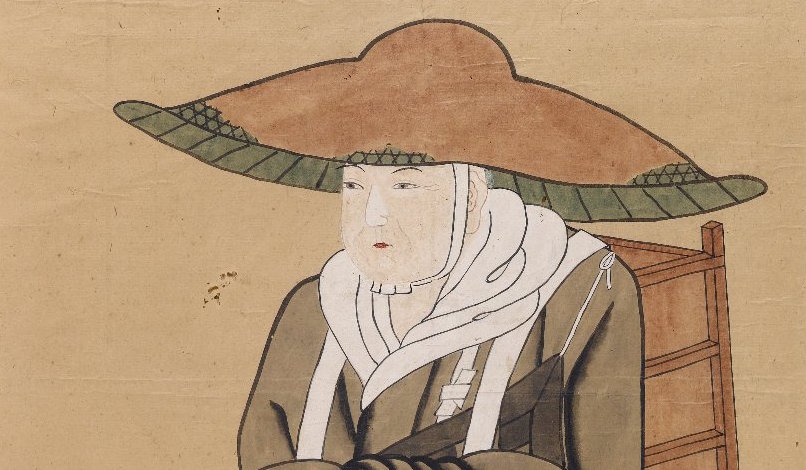
Image credit: Brooklyn Museum
Xuanzang was the well-born son of a scholar-gentleman living (by choice) on the outskirts of the short-lived and ill-fated Sui dynasty (581-618). Xuanzang’s older brother was a Buddhist monk. When Xuanzang showed enthusiasm and aptitude for the profession, he was sent to a monastery in the capital to follow in his brother’s footsteps. The capitol collapsed when the Sui dynasty did. Xuanzang’s official biographer recounts how “the whole kingdom was in confusion. The capital became a rendezvous for robbers and the district around a resort of wild beasts. The magistrates were destroyed and the body of priests either perished or took to flight. The streets were filled with bleached bones and the burnt ruins of buildings.” Xuanzang and his brother fled.
By 623, the new Tang dynasty had imposed order across much of China. Xuangzang, now in his mid-twenties, began traveling the country. This was an accepted part of the education of a promising monk. Different monasteries maintained different traditions. Their abbots held different theological interpretations. A learned monk should be familiar with all of it. Xuanzang traveled widely and gained a reputation for his depth of knowledge. Yet in his journeying, Xuanzang discovered that the holy books in different monasteries contradicted one another! Over time, their teachings had drifted apart until the young monk couldn’t tell which were correct. So he decided to follow the example of two earlier Chinese monks. He would travel to India, the birthplace of Buddhism, collect Buddhist scriptures written in the original Sanskrit, and return with them to China.
Unfortunately, leaving China was illegal. The new Tang government was still getting established. Banditry and unrest were common in parts of the country. To exert greater social control, the government forbade its citizens from leaving China. There were apparently concerns about peasants running off and depriving China of their labor, or of fleeing to the hinterlands to turn bandit, or maybe even of rich people taking their wealth out of the country to start new lives someplace else. Foreigners could still come and go; the country wasn’t closed off to trade. But Chinese Buddhist monks certainly couldn’t go gallivanting off to India just because their holy books had been corrupted.
(Now seems as good a time as any to mention that Xuangzang’s story would later inspire the 16th-century novel Journey to the West, possibly the best-known literary work in East Asia.)
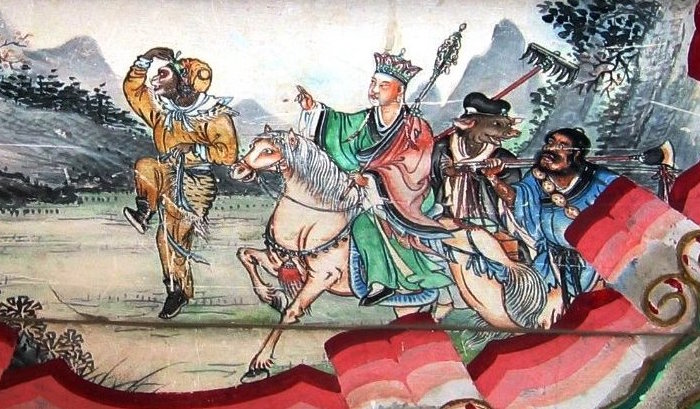
Image credit: Rolf Müller. Released under a CC BY-SA 3.0 license.
There were two ways from China to India, both risky. In the Middle Ages, Asia would be bound together by trade routes and shipping lanes that permitted the free exchange of goods and ideas (and fairly safe travel) that would take Europe almost a thousand years to equal. When Xuanzang set off, though, this network was just getting started. The first route was by ship south from China, around the Malay Peninsula, and west to India. You’d probably have to change ships at least once along the way. The other route was overland: west across the Taklamakan Desert in what is today Xinjiang, south through the cities of Tashkent, Samarkand, and Balkh in Uzbekistan and Afghanistan, and finally east through Pakistan and down the Ganges into India. That’s over twice farther than ‘as the crow flies’, but a direct route would take you over the wall of the Himalayas and through Tibet which was, at the time, a rising power hostile to China, India, and Buddhism. Xuanzang opted for the overland route.
But the word was out about his intentions. He was a monk, not a spy; no surprise he couldn’t keep a secret. The local governor knew and liked Xuanzang. He summoned the monk before him to ask if the rumors were true. Xuanzang hemmed and hawed but ultimately admitted that, yes, he was headed for the border to sneak across it and leave China. The governor, a pious Buddhist, tore up the letter that had warned him of the monk’s intentions and ordered Xuanzang to flee west immediately before anything else happened.
But the path over the border was long and difficult. Xuanzang needed a guide – a coyote, if you prefer. And who should come into the Buddhist temple but just such a person, a foreigner named Shi Panto. They hit it off. Xuanzang’s biographer frames their relationship as Shi becoming Xuanzang’s lay disciple, but I’d be surprised if some money didn’t change hands too; guides don’t work for free. Shi introduced Xuanzang to an old man who’d made the trip many times and warned the monk, “The Western roads are difficult and bad; sand-streams stretch far and wide; evil spirits and hot winds, when they come, cannot be avoided: numbers of men traveling together, although so many, are misled and lost; how much rather you, sir, going alone! How can you accomplish such a journey? I pray you, weigh the thing with yourself well, and do not trifle with your life.”
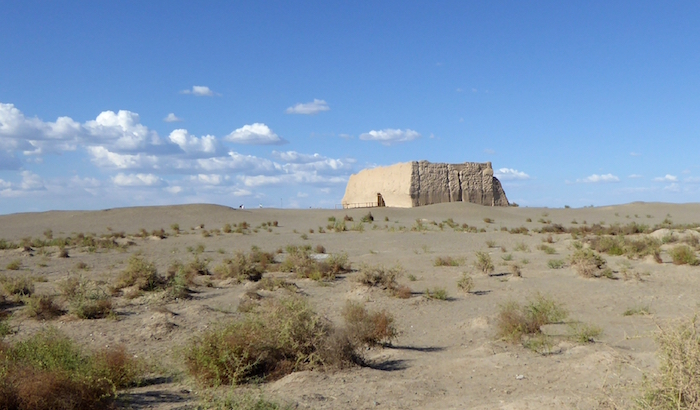
Image credit: Hiroki Ogawa. Released under a CC BY 3.0 license.
The first obstacle Xuanzang and Shi faced together was the Yumen Gate: a large, squat guard post along the western road, flanked by miles of walls. A river ran along the base of the walls. All westbound traffic was to pass through the gate. Xuanzang and Shi would surely be arrested if they tried it. But Shi knew that three miles upriver from the gate, the wall ended at a spot where the river was deep but only eight feet wide. They cut down trees to make a bridge, lay branches across it, spread sand atop the branches, and led their horses across.
That night, Shi may have tried to rob Xuanzang. In the middle of the night, Shi got up, pulled out a knife, approached the monk, and then turned around. This woke Xuanzang. The monk wasn’t sure what Shi was up to, so he also got up and started reciting scripture, calling especially on Guanyin, the bodhisattva of compassion. Shi, having visibly freaked out Xuanzang for unclear reasons, went back to bed.
Modern states have firm borders and are often pretty uptight about enforcing them. And while China in this moment was similarly uptight about border crossings (not a given in the premodern world), it certainly did not have a clear, sharp border. Though Xuanzang and Shi had bypassed ‘customs’, they had a long way to go before they were free of Chinese control. There were five signal towers along the road. They communicated during the day by smoke signals and at night by fires. There was no water or grass for the horses along the road except within bowshot of the towers. These were an early warning system to notify western China when a nomad raid was spotted heading east. Xuanzang’s biographer reports the towers were 30 miles apart. That may be a bit of an exaggeration; for two towers to see one another across thirty miles, each would need to be 115 feet tall. If you reduce the distance to 20 miles, they only need to be 50 feet tall. Whether 20 miles or 30, sneaking past all five watchtowers was going to be tricky, especially since they’d need to creep up on each in the middle of the night to retrieve water.
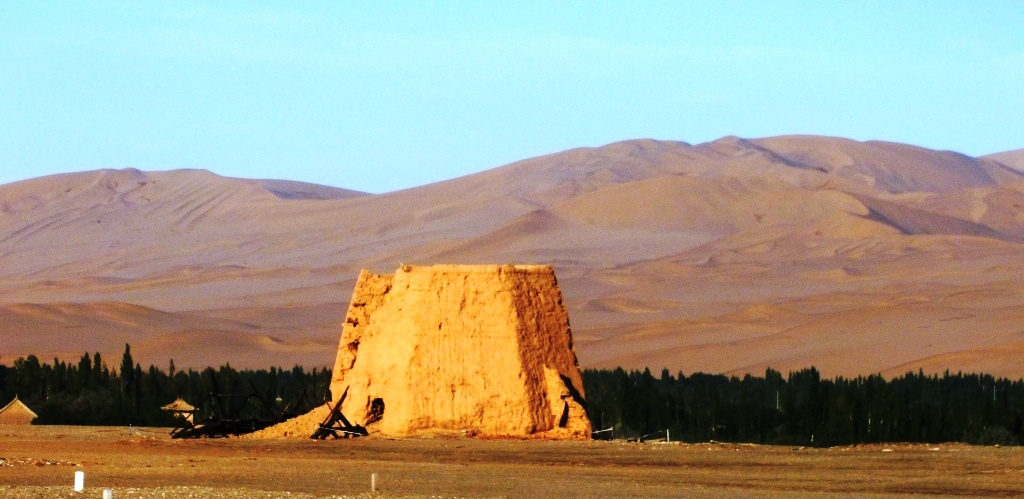
Image Credit: John Hill. Released under a CC BY-SA 4.0 license.
Shi soon abandoned Xuanzang in the desert, perhaps after another robbery attempt. Shi encouraged Xuanzang to ride in front while the guide had his knife out and his bow strung. Xuanzang repeatedly declined. After a few miles with the guide in front, Shi suddenly remembered he had urgent family business back in China and rode back east, leaving as Xuanzang’s only guide the occasional piles of bones and horse dung left by earlier travelers.
Now, alone, Xuanzang began to hallucinate, perhaps due to a combination of the stress, the heat, and desert mirages. He saw advancing across the plain hundreds of soldiers clad in fur and felt, horses, camels, standards, and glittering lances. They multiplied, becoming thousands of forms in the wastes. Sometimes they appeared close, then far away. Finally they vanished altogether, and he heard in the void voices calling out, “Do not fear. Do not fear.”
Xuanzang finally reached the first watchtower. He waited until dark, then snuck to the oasis at the foot of the tower. As he began to fill his water-vessel, an arrow whistled past him and cut his knee. He was spotted! Out of fear for his life, he cried out, “I am a monk! Don’t shoot me!” The guards opened a gate and saw, much to their surprise, that he was telling the truth! It turned out the guards weren’t Han (ethnic Chinese) but Tanguts, from an ethnic group that lived west of China. The commander of the watchtower, Wang Siang, knew about Xuanzang but had heard he’d given up and headed back east. Wang thought the prohibition on western travel was silly – which makes sense, him being a westerner and all. He was also a devout Buddhist. Wang volunteered to guide Xuanzang much of the rest of the way. He escorted the monk past the second and third watchtowers and almost all the way to the fourth. He told Xuanzang that he should stop at the fourth watchtower and introduce himself to the guard captain there, Wang Pilung, who was a relative of the first Wang. Wang Siang then returned to his watchtower, leaving Xuanzang once more alone.
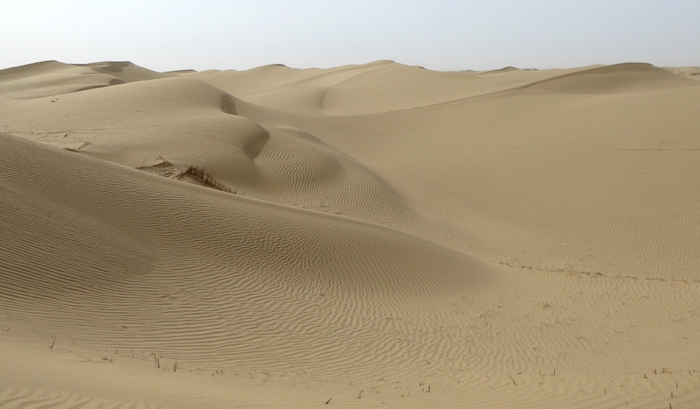
Image credit: Hiroki Ogawa. Released under a CC BY 3.0 license.
It wasn’t that Xuanzang didn’t trust Wang Siang. He was just very afraid of detention. So once again, he waited until nightfall to sneak up and try to fill his water-vessel. And once again, he was spotted and brought inside. And, wouldn’t you know it, Wang Pilung was just as nice as Wang Siang had said. Wang Pilung couldn’t escort Xuanzang, but he gave him another big waterskin and a warning: “Don’t go towards the fifth watchtower. The men there are rude and violent, and some mishap may befall you. Thirty miles from here is a spring where you can replenish your supply of water. Go there instead.” This is all we learn of the fifth watchtower; the text never mentions it again.
Having presumably gassed up at the spring, Xuanzang pressed on into the Taklamakan Desert, about 250 miles across. It’s a sandy, empty place. One folk etymology for the name is that it’s derived from a phrase meaning “once you go in, you never come out.” This time, instead of soldiers, Xuanzang saw goblins! These strange demon shapes seemed to surround him and press in on him from every direction. He called once more on the bodhisattva Guanyin, but this time to no avail. Only when he read from a little sutra book given to him in gratitude by a sick man he’d once helped was Xuanzang able to banish these apparitions.
But by now Xuanzang was turned around, no longer sure where the caravan path was. Worse, he spilled all his water. For five days and four nights he went without. He saw demons making fires upon the sands as numerous as the stars. He traveled until he could move no more and laid down to die. On the fifth night, Xuanzang dreamed he saw a mighty being, dozens of feet high, holding a halberd. The spirit urged the monk on. So Xuanzang got up and rode on. After a few miles, his horse decided to go in another direction and could not be deterred. So the monk rode, powerless, until they came to a pool of sweet water and acres of green grass: a miracle Xuanzang attributed to Guanyin.
Xuanzang survived to cross the desert and was treated with honor by the Buddhist kingdom on the far side. He made it all the way to India, studied there for over a decade, and returned to China with the sacred texts he’d sought. His crime of illegal border crossing was forgiven and he was praised by the Tang emperor.
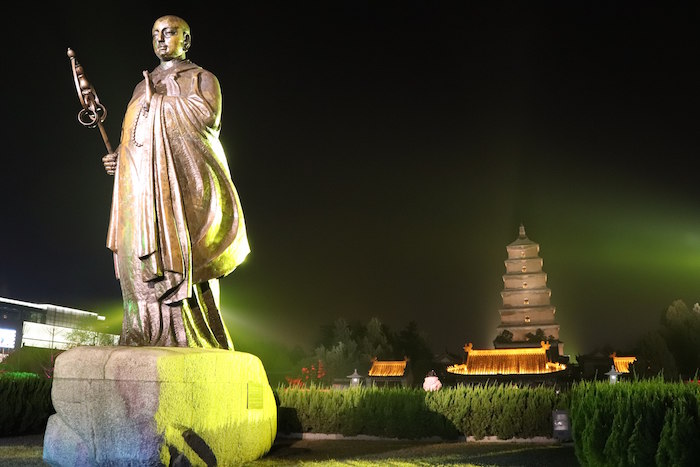
Image credit: Liuxingy. Released under a CC BY-SA 4.0 license.
At your table, Xuanzang’s trip across the border makes a good template for a session while the PCs are traveling. You get hauled before the governor, have to sweet-talk him into letting you go, have to find a guide (or suss out that the one you’ve got is untrustworthy), get warned off by an old man, sneak around a wall, and then sneak past each tower. Along the way, you might encounter mirages (or are they mirages?) and get robbed by your guide. For the first watchtower, roleplay out sneaking up to it at night to gather water. Call for some rolls. If the PCs succeed, resolve each subsequent watchtower with only a single roll to keep things from getting repetitive. The first time the PCs fail and are spotted, they get the same stroke of good luck Xuanzang did – the guards are sympathetic and want to help! For any further towers, though, the guards are just as rude and violent as in Xuanzang’s tower five.
If your party isn’t crossing a desert, that’s no trouble. All you need is terrain that forces the PCs into a narrow area so they have to interact with the towers. Mountains and dense forest are a terrific substitute, even in modern or science-fiction settings. There’s still about a hundred-mile stretch of the Rocky Mountains in Idaho that don’t have a road running from west to east; to cross the Rockies, you gotta go around via a north route or a south route. Ditto the Darién Gap, a stretch of marshes, mountains, and jungle in southern Panama; there’s no overland route between North and South America. You’ve got to take a ferry to get around the Darién Gap. In something like Star Trek, you can use a weird-colored energy anomaly for the same purpose.
If the PCs aren’t crossing an international border, you can still use this material! Maybe relations between two neighboring provinces are bad and one province has decided not to let its residents cross into another. Maybe one nation has claimed land significantly beyond what it says on the map. Heck, maybe the towers are an elaborate internal control point. All that matters is there’s a law on the books that makes the PCs want to avoid those towers, but some element of the terrain that means they can’t just add two weeks to the journey and go around.
Sources:
The Life of Hiuen-Tsiang, translated by Samuel Beal (1911) Hiuen-Tsiang is a non-standard romanization of 玄奘, which in standard pinyin romanization is Xuánzàng. This is the biography of Xuanzang written by an apprentice of his. Xuanzang also wrote a long book about his travels, Great Tang Records on the Western Regions, but it doesn’t say anything about sneaking out of China.
When Asia was the World by Stewart Gordon (2008)






